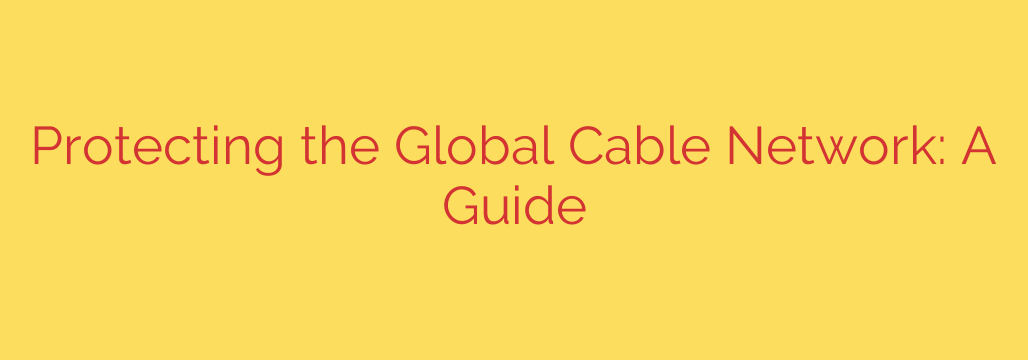
Guardians of the Deep: Securing the Undersea Cables That Power Our Digital World
In an age of wireless connectivity, it’s easy to forget that the global internet is a physical marvel. Every click, stream, and international transaction is powered not by satellites or clouds, but by a vast, hidden network of submarine fiber-optic cables. These undersea lifelines are the true backbone of our modern world, and their security is one of the most critical, yet overlooked, challenges of our time.
Over 99% of all international data travels through these cables, which span hundreds of thousands of miles across the ocean floor. They are the conduits for everything from financial markets and government communications to social media and video calls. The sheer importance of this infrastructure means that any disruption—whether accidental or malicious—can have immediate and catastrophic consequences.
A Spectrum of Threats Beneath the Waves
The vulnerability of this global network is not theoretical. The threats are diverse and growing, ranging from everyday accidents to calculated acts of aggression. Understanding these risks is the first step toward building a more resilient digital future.
Key threats to the submarine cable network include:
- Accidental Damage: This remains the most common cause of cable failure. The primary culprits are accidental damage from fishing trawlers and ship anchors, which can drag across the seafloor and sever a cable. A single break can disrupt connectivity for an entire region.
- Natural Disasters: The ocean floor is a dynamic environment. Underwater earthquakes, volcanic eruptions, and submarine landslides can easily damage or destroy cables, especially in geologically active areas like the Pacific Ring of Fire.
- Deliberate Sabotage: In a world of increasing geopolitical tension, these cables represent a significant strategic vulnerability. A hostile state or terrorist group could intentionally target and cut cables to cripple a nation’s economy, disrupt military communications, and cause widespread civil chaos. Their remote locations make them incredibly difficult to defend.
- Espionage and Data Tapping: While more complex than simply cutting a cable, it is technologically possible to tap into fiber-optic lines to intercept sensitive data. This form of espionage poses a profound threat to national security and corporate intelligence.
A Multi-Layered Defense for a Global Asset
Protecting this critical infrastructure requires a coordinated, multi-layered approach involving governments, private industry, and international partners. There is no single solution; instead, security relies on a combination of physical, technological, and legal safeguards.
1. Enhanced Physical Monitoring and Protection
The first line of defense is knowing where the cables are and what is happening around them. This involves clearly marking cable zones on maritime charts to warn off ships. In high-risk areas, cables are often buried beneath the seabed for added protection. Furthermore, increased maritime patrols and the use of advanced surveillance technologies, such as sonar and unmanned underwater vehicles, can help monitor for suspicious activity near critical cable routes.
2. Network Redundancy and Resilience
It’s impossible to prevent every cable break. Therefore, the most effective defense is resilience. Network redundancy, which means having multiple backup pathways for data, is crucial. When one cable is damaged, traffic can be automatically rerouted through others with minimal disruption. Tech companies and telecom operators are continually investing in new, diverse cable routes to avoid single points of failure.
3. International Law and Cooperation
Protecting assets in international waters is a complex legal challenge. Strengthening international treaties and maritime laws that govern the protection of submarine cables is essential. This includes establishing clear consequences for deliberate damage and fostering international cooperation to investigate and respond to incidents. Public-private partnerships are vital, as the majority of these cables are owned and operated by private companies.
4. Advanced Technological Safeguards
Beyond physical security, technology offers powerful tools for protection. Strong, end-to-end data encryption ensures that even if a cable is tapped, the information flowing through it remains unreadable and secure. Additionally, real-time network monitoring systems can instantly detect a drop in performance or a break, allowing for faster repair and rerouting.
Strengthening Our Digital Defenses: What You Can Do
While much of the responsibility for cable security lies with large organizations, businesses and even individuals can play a role in promoting a more secure digital ecosystem.
For businesses, this means diversifying data center locations and cloud service providers to avoid reliance on a single geographic region or network path. Implementing robust cybersecurity protocols protects data at its endpoints, which is just as important as protecting it in transit.
Ultimately, the security of our shared digital world depends on recognizing its physical foundations. These undersea cables are the unsung heroes of the internet age. By understanding their vulnerabilities and committing to a robust, collaborative defense strategy, we can ensure that the global pulse of information continues to beat strong for generations to come.
Source: https://www.helpnetsecurity.com/2025/09/30/protect-undersea-cable-security/








